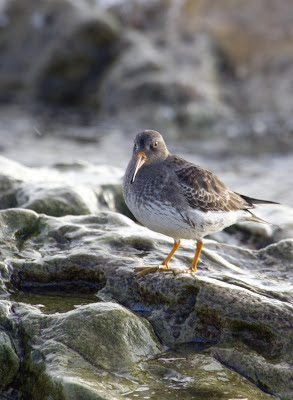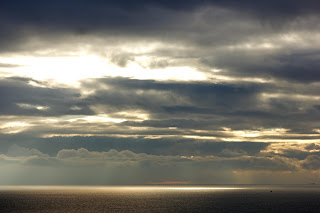Kings cave is part of a group of caves that sit north of
Drumadoon on the Isle of Arran. The
caves are formed from sandstone and are steeped in history. One of the most
famous associations and the origin of the title Kings Cave comes from the
belief that Robert the Bruce had his spider encounter within the cave. In the 17th century the cave was
associated with the mythical Irish hero Fionn and his warriors and some texts
of this era refer to the cave as Fingal’s Cave. What is certain is that throughout time the cave has been
used for shelter, worship and teaching and whereas modern day graffiti is done
with a spray can, historical markings were made with the tools available at the
time.
.jpg) Carvings date back many centuries, possibly even to bronze
age (Machrie Moor stones are about 1 mile away) and have been worn away or
overlaid by both more recent carvings and mineral deposits. The caves are now
an easy circular walk (from the kings cave carpark).
Carvings date back many centuries, possibly even to bronze
age (Machrie Moor stones are about 1 mile away) and have been worn away or
overlaid by both more recent carvings and mineral deposits. The caves are now
an easy circular walk (from the kings cave carpark).
On entering the cave serpents can be found about 4 meters in
just above head height on the left.
 Once
these are found it is quite easy to pick out Ogham inscriptions slightly to the
left of the serpents and a meter or so to the right – all at the same
height. Oghan inscriptions are a
medieval type of alphabet or cypher, sometimes known as the ‘Celtic Tree
Alphabet.
Once
these are found it is quite easy to pick out Ogham inscriptions slightly to the
left of the serpents and a meter or so to the right – all at the same
height. Oghan inscriptions are a
medieval type of alphabet or cypher, sometimes known as the ‘Celtic Tree
Alphabet.
At the rear of the cave the tunnel forks. The left hand side has many 19th
century engravings and a modern Christian symbol.
The central buttress has a large Latin cross inscribed on it
with other concentric lines near the base.
This has been reworked many times and has had various interpretations,
from a two handed sword (associated with Bruce and Fionn), Christian cross and ‘tree of life’ a common motif in early
Christian art.
Immediately to the right of the ‘cross’ is a human figure,
with hands raised. This hands raised
position is believed to represent the prayer position. Above the head is two curved lines (upside
down w). Various interpretations have
been made of this, from it being hands joined, hair or a bow.
Moving down the right hand fork to where the tunnel narrows
significantly (a torch will be needed), older animal carvings can be
found. The furthest is believed to be a
horse (head height) and below that (near
the floor) a horse and rider.
These appear
quite different styles and are probably from very different dates but iron age
is suggested.
Moving back towards the entrance but still within the right
fork of the tunnel, at shoulder / head height, a very clear square carving can
be seen that appears to represent a house.
A little more to the right and two
animals can be seen together. These
could be a deer and calf, or deer and hound.
and very faintly to the right of
this and now being slowly covered with algae and mineral deposits is another
human figure.
Another two meters right and at floor level a circles with a
centre dot can be found.
Much nearer the entrance and on the overhanging ledge are
two shields / masks / animal faces. I
prefer the suggestion of animal faces when a torch is played over the carvings.
There are more to be found than those listed here, although
some do require a good dollop of imagination!












.jpg)










.jpg)


.jpg)


.jpg)

.jpg)










